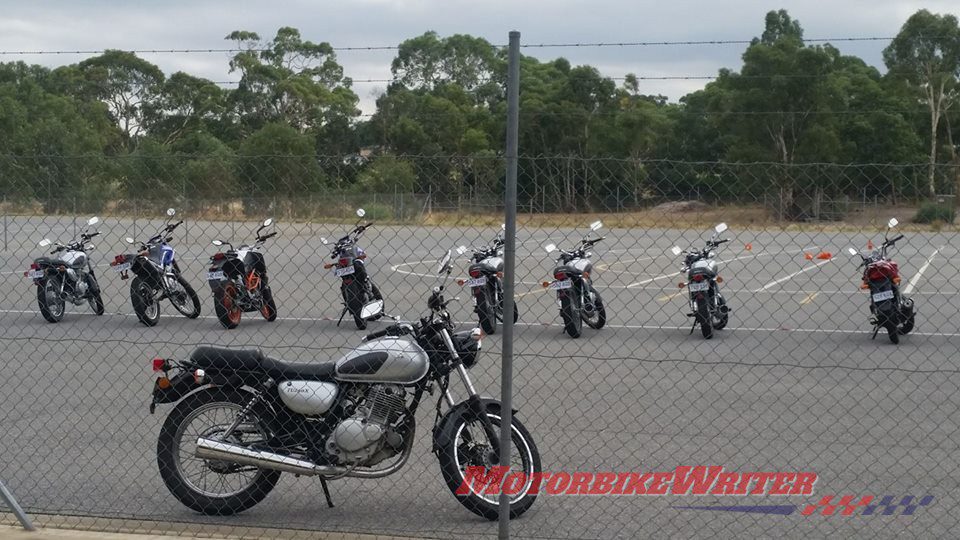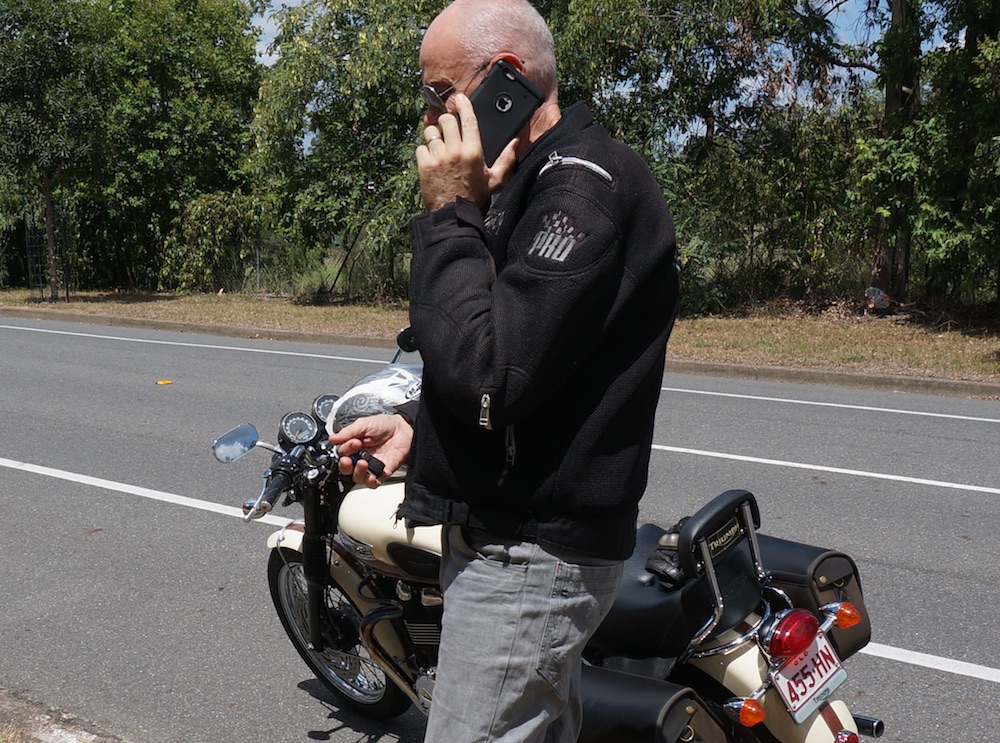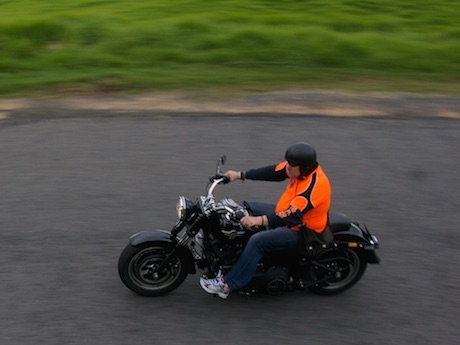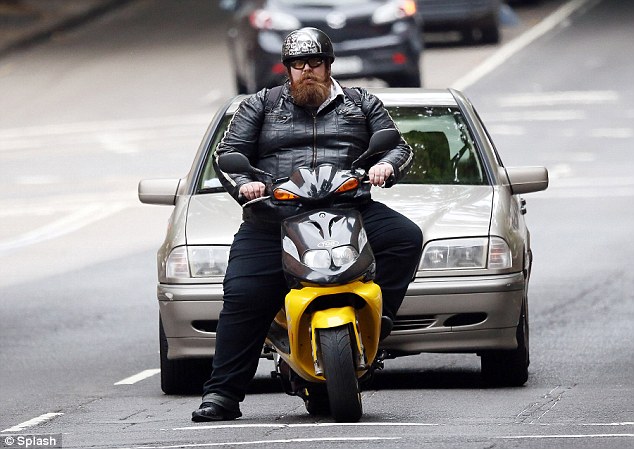This is the full text of the Ride to Review submission to proposed South Australia Centre for Automotive Safety Research changes in the motorcycle graduated licensing system (GLS).
It was compiled by the group’s management committee with input from more than 2100 members and supporters, and research from Road Safety, Education and Psychological experts from within Australia, and internationally.
Click here for the brief overview.
1.1 Three stage hierarchical model
GLS Elements Recommended by Christie (Austroads, 2014)
Recommendation: As South Australia already has a three stage hierarchical model in place, which parallels the car GLS and is consistent with other Australian jurisdictions, there is no need for change.
RTR response
– Agree
- Motorcycle licensing should follow the requirements of Learner, Red P, Green P, full licence, as is currently for obtaining a car licence.
1.2 Requirement for 12 months car licence tenure
Recommendations: In Victoria, a prospective motorcyclist must be 18 years old before being able to apply for a learner motorcycle permit. The required age for a car learner permit is 16; the required age for a probationary car licence is 18. The Victorian system most likely effectively encourages people to learn to drive a car before a motorcycle but does not mandate it. This option would appear to be fairer for those who wish only to ride a motorcycle. It is also likely that the greatest benefit of the car licence prior to attaining a motorcycle licence class is by-product of a delay in exposure and greater maturation at an older age. These can be achieved by simply mandating an older learner permit age without mandating a car licence first. It is therefore recommended that South Australia follow the Victorian system. Accordingly, the minimum age for a motorcycle learner permit in South Australia should be raised to 18 but a minimum tenure with a car licence should not be a requirement for applying for a motorcycle permit.
RTR response
– While Queensland’s motorcyclist GLS requires applicants to have a minimum tenure of one year on a car licence before being eligible to obtain a motorcycle learners permit, “no specific evaluation of the measure has yet been undertaken” (Christie, p 25, 2014), so arguing that this has had a positive impact on fatalities and/or serious injuries to the under 18 age bracket is a tenuous link at best.
– The recommendation that the applicant minimum age be raised to 18 when, statistically, South Australia rider deaths in this age bracket are negligible, especially when compared to the 30 – 45 year age bracket, or the ‘returning rider’ group, predominantly in the over 45 year age bracket, is one that RTR is unable to support.
– Raising rider eligibility to 18 is a move that will have a negative impact on economic, social and sporting access and opportunities.
– Access to employment opportunities for young people with limited funding for a car, and being unable to access public transport due to geographical factors, will be reduced.
– Access to participation in many off-road motorsport pursuits will be denied if applicants are unable to obtain a learners permit at the current entry level, as many of these pursuits require transit via public roads or use public roads as part of their courses.
– Access to social pursuits for many regional and rural young people will be denied through lack of public transport options.
– While it is acknowledged that young people often lack the cognitive skills and neurological development to navigate the complexities of cause and effect in, potentially, higher risk situations, than that of being in a car, training and support as outlined by Glendon (An approach to novice driver training, 2014) with strategies such as testing for ‘risk taking’ propensity, competence in dealing with hazards and hazard perception, ‘fast tracking’ the development of mental imagery appropriate to high hazard environments, and including the role that mentoring can play in supporting young people with appropriate decision making in high risk situations in a ‘safe’ (supervised) environment has the same potential to mitigate the risk of fatality and/or serious injury that is being proposed by a nominal 2 years of maturation for a young person.
– While CASR has acknowledged, through research that is now almost 20 years old and not based on the Generation Y cognitive development, that “riders older than 25 had less than half the risk of those aged 15 – 19”, the researchers, Mullin et al, concluded that greater riding experience was the reason for this, without acknowledging the role that cognitive neuroscience plays in the risk assessment and decision making process (Glendon 2014, Westwell 2011 – Cognitive Neuroscience: implications for career development strategies and interventions) With cognitive supports and training as part of the rider safe courses for licensing, or as part of a post learner mentoring/coaching program, the negative impacts of raising the eligibility age to 18, as listed above, need never need to be felt.
– RTR counter proposes that learner eligibility remain at 16 years with additional focus on cognitive development and higher order thinking skills as part of the training processes.
– RTR proposes a consultative and collaborative approach to the re-development of RiderSafe courses for Learner and R-Date riders.
1.3 Minimum tenure periods for learner and intermediate phases
Recommendation: The aim of a GLS is to ensure that novices obtain experience in low risk conditions for a considerable period before advancing to less restrictive licensing phases. Having a minimum tenure period for each phase of a motorcycle GLS would help serve this objective, along with the imposition of various restrictions advocated in the present report for the learner and intermediate phases. It is recommended that the learner phase should have a minimum tenure of six months, and intermediate phase (R-Date licence) should have a minimum tenure of three years. These periods should apply regardless of other licences held, and regardless of age.
RTR Response
– Agree to 6 months tenure for Learners Permit
– Agree to 3 years tenure for R-date licence for riders under the age of 21 years and 6 months (if learner entry remains at 16 years of age)
– RTR counter proposes If a learner rider is already over the age of 21 and 6 months, the R-date tenure should only be 2 years as this reflects their greater maturity level, cognitive abilities and potential for having greater road user experience through holding a car licence previously.
– For riders who complete their 3 years tenure on R-date but are still under the age of 21 and 6 months, they will obtain full unrestricted user conditions, with the exception of the ability to ride a non-LAMS motorcycle, as this is comparable to young drivers being unable to drive high powered vehicles until reaching the age of 25
– Full unrestricted licence conditions will only be achieved if the end of the R-date tenure falls after the rider has obtained 21 years and 6 months of age
1.4 Clean record for graduation to next GLS level
Recommendation: Currently, in South Australia, as elsewhere in Australia, behaviour during the GLS for car drivers and motorcyclist is controlled through lower demerit point limits than apply for full licences. The demerit point limits are likely to be sufficiently low that they effectively require very low rates of nonoffending. If these low limits are also applied to the longer minimum periods of tenure in the different GLS phases recommended above (2.3), then novice riders will have to maintain long periods of nonoffending in order to progress through the GLS. For this reason, it is not necessary to recommend minimum offence-free periods before graduation to subsequent GLS phases.
RTR Response
– Agreed
1.5 Display of distinctive plates
Recommendation: South Australia should require riders with an R-Date licence class to display P plates whilst riding.
RTR Response
– Agreed that Learner riders need to display an ‘L’ Plate while riding
– Agreed that R-date riders display a Red P for the first 12 months, if over the age of 21 and 6 months, or first 24 months, if under the age of 21 and 6 months (given that the learner eligibility age remain at 16 years).
– All R-date holders must display a Green P for the final 12 months of their R-date tenure
– As this will put a far greater number of riders at risk of rear end collisions while travelling in traffic, as they will be ineligible to undertake lane filtering if required to display a ‘P’ Plate, RTR proposes that current lane filtering legislation be updated to permit riders displaying P plates to filter
- As it is currently part of the R-date course that riders are required to control their motorcycle while travelling at low speed (the situation for lane filtering), riders holding an R-date licence have been taught the necessary skills to undertake this manoeuvre safely.
1.6 Mandatory carriage of licence
Recommendation: Strict mandatory carriage of licence laws could be considered in South Australia for all operators of motor vehicles, which includes motorcyclists. These laws would remove the opportunity for motorists to produce their licence at a later date or time and may help deter unlicensed motorcycle riding.
RTR Response
- Agreed
1.7 No carriage of pillion passengers
Recommendation: As a pillion is likely to make riding more difficult for a novice, both in terms of maintenance of balance and as a potential source of distraction, and as pillions have a greater risk of serious injury than riders in the event of a crash, it is recommended that South Australia prohibit riders on learner permits and R-Date licences from carrying pillion passengers.
RTR Response
– Agreed to no carriage of pillion passengers for Learner riders
– Partially agree to no carriage of pillion passengers for R-date riders
RTR counter proposes If R-date tenure is to be extended, pillion passengers should only be permitted in the final year of tenure (whether this be year 3 for a rider under the age of 21 and 6 months, or year 2 for a rider over the age of 21 and 6 months), while the rider is displaying their Green P plates
– The R-date course must include the training of riders in both how to be a pillion, and how to train a pillion, so that safe carriage will be undertaken once licensing conditions permit, exemplified in the Northern Territory’s intermediate course to obtain a restricted motorcycle licence.
1.8 Night-time Curfew
Recommendation: Night time curfews for novice drivers have been enacted in South Australia without a marked loss of mobility, and initial results are suggestive of a decline in night time crashes among this group. Currently, riders with an R Date licence who are under 25 years of age, and who are without a car licence or only hold a P1 car licence, are prohibited from riding between midnight and 5am. This restriction would ideally be expanded to include all riders without a full motorcycle licence. However, as the car GLS specifies only those under the age of 25, it would arguably be inequitable to apply the motorcycle night restrictions to riders of all ages. However, it should be applied to all appropriately aged riders with an R Date licence regardless of other licences held. It should also be applied to all riders with a learner permit, regardless of other licences held and regardless of age
RTR Response
– while it is accepted that night time riding poses greater risks to a rider, not only from other vehicles who may ‘look but fail to see’ a rider, but also from wildlife and other road hazards that are not present during the day, the total restriction from night time riding from midnight to 5am is not reflective of peak crash times and days.
– The Centre for Accident Research & Road Safety – Queensland (CARRS-Q) outlined in their Motorcycle Safety fact sheet of May 2012 that peak crash times occurred on the weekends, and between 2 and 6pm.
– “Crashes involving a motorcycle fatality peak in the day (9am to 3pm) and evening (3pm to 9pm). One third of fatal motorcycle crashes occur on a weekend between 9am Saturday and 9pm Sunday.” Motorcycling Safety BITRE May 2017.
– RTR counter proposes that a weekend night time curfew be put in place (from midnight until 5am) for learner riders, irrespective of other licences held, and R-date riders displaying Red P plates and being under the age of 21 and 6 month, to be comparable to the rules for probationary car drivers. This is also reflective of peak crash times and days for motorcycle riders.
– Exemptions to this need to be made for those riders using a motorcycle for transportation to and from employment only, where alternative opportunities, such as public transport, do not exist.
1.9 Zero BAC
Recommendation: There is a strong relationship between alcohol consumption and crash involvement among motorcyclists, and a zero BAC when riding a motorcycle is a requirement as part of the GLS in the majority of Australian jurisdictions. Therefore, it is recommended that all
riders with a learner permit or R-Date licence, irrespective of other licences held, must have a zero BAC when riding.
RTR Response
- Agreed
1.10 No towing of Trailers
Recommendation: Given that towing may increase risk for novice riders and that few riders would be negatively affected by prohibition of towing, is recommended that a towing restriction be put in place for riders with a learner permit. It would be reasonable to permit towing for riders with an R-Date licence.
RTR Response
– Agreed for Learner riders
– RTR counter proposes that R-date riders should only be allowed to tow a trailer in the final year of their R-date tenure, while displaying Green P plates, if tenure is extended beyond current terms.
1.11 No use of mobile phone or other communication device
Recommendation: Mobile phone use, whether hand-held or hands-free, is known to impair driving related tasks. All phone use while driving has therefore been prohibited for novice car drivers within the South Australian GLS. This should be extended to all novice riders (learners and R Date) within the motorcycle GLS, irrespective of other licences held
RTR Response
– Agreed regarding mobile phone use – hands free or hand held
– RTR counter proposes that other communication devices such as rider to rider communication and GPS navigation should be permitted as these have benefit to a rider when being mentored/coached, and for navigation purposes.
– Novice car drivers are able to take GPS navigation instruction and communicate with passengers, so this will keep restrictions comparable.
1.12 Lower demerit point threshold for licence disqualification
Recommendation: It is recommended that the lower demerit point thresholds that are applied in the learner phase also be applied when the rider holds an R Date licence. However, if a minimum three-year tenure is required for R Date licences, then consideration should be given to demerit point limits per year rather than across the entire tenure of the R Date phase.
RTR Response
– Agreed
1.13 Automatic transmission restriction for novice riders
Recommendation: There is a sound theoretical basis for requiring that a rider demonstrate competency on a manual motorcycle before being licensed to ride one. South Australia should adopt the restriction to an automatic motorcycle if tested on one that applies in the majority of other jurisdictions in Australia. This should be the case for both the learner permit and R-Date licence
RTR Response
– Agreed
1.14 Enhanced visibility requirements
Recommendation: Requiring learner riders to wear high visibility clothing should provide a benefit not only in aiding conspicuity but also would alert other motorists to the inexperienced nature of the rider. As such riders are likely to still be learning road craft (including positioning), their feeling complacent about their visibility is less likely. South Australia should follow the lead of Victoria and require that motorcyclists with a learner permit wear high visibility clothing when riding.
RTR Response
– RTR does not agree with this recommendation
– As outlined in the CARR-Q ‘State of the Road’ fact sheet, 2012, 58% of fatal motorcycle crashes involved another vehicle. In multi-vehicle crashes, the other vehicle was most often at fault. Commonly, this involved violations of the motorcyclist’s right of way – highlighting the importance of defensive riding skills and active risk management for riders.
– At no point is the use of HiViz suggested as a way to mitigate these violations.
– A Victorian parliamentary enquiry into motorcycle safety in 2014 failed to find conclusive correlation between the wearing of HiViz clothing on a motorcycle and increased conspicuity on the road, as the confounds of studies such as HURT and MAIDS, and the, now over a decade old, NZ study used to justify this recommendation, are that those who voluntarily wear HiViz clothing are likely more conservative by nature in their riding style to maintain conspicuity on the road.
– Recent research by the Australian National University has purported the ‘look but fail to see’ phenomenon towards motorcyclists, irrespective of headlights or clothing worn.
– Motorcycles, being small and often faster moving than other vehicles, are not perceived as a ‘threat’ when information from the eyes is processed by the amygdala (lizard brain – area that processes the ‘fight or flight’ response), thus often producing the ‘look but fail to see’ reaction from car drivers.
– Cognitively a person will retain approx. 80% of what they have personally experienced, thus alerting the brain to its relevance – meaning that those who have ridden motorcycles, or have them as part of their ‘awareness’ will be far more likely to see them in traffic and on-road situations. This is supported by research conducted by numerous insurance companies in the UK, concluding that those who ride motorcycles are 30% less likely to make a claim for a car incident. The University of Nottingham concurs in its 2012 paper “Driving experience and situation awareness in hazard detection” that motorcyclists have up to 50% greater hazard detection when in a car than those who only drive a car.
– Australia Post, who’s delivery staff are all required to wear HiViz, has no significant data to support the wearing of HiViz either. Some regions report no significant change in incidents. Some report a reduction in incidents – it’s subjective. Australia Post reports a reduction overall, but they can’t account for whether it was the hi viz, the extra safety training or whether reporting has dropped due to disincentives of more detailed investigations and remedial programs following a reported incident.
– As the brain detects movement before registering colour it is recommended by RTR that more comprehensive training be undertaken on-road at learner and R-date level to instill road craft skills and the necessity for greater conspicuity on the road. Being more aware of other road users blind spots in a variety of on-road situations, eg dual carriageway, multi-carriageway, in filtering situations, etc, will provide greater assistance towards motorcyclist conspicuity to other road users than the wearing of HiViz clothing – particularly in urban areas where there is a plethora of visual distractions and colours along carriageways.
– In addition, since, as reported by CARRS-Q, and outlined above, in over half of motorcycle fatalities another vehicle is involved, and overwhelmingly, in these cases, it is the fault of the car driver violating the motorcyclist’s right of way – providing opportunities for car drivers to be more aware of motorcycles on the road by adding greater emphasis on specifically looking for them as part of the on-road learner phase (whether this is through formal instruction, or parental instruction) will share the responsibility for conspicuity in incidents between cars and motorcycles.
1.15 Mandatory protective clothing requirements
Recommendation: The use of protective clothing is a proven countermeasure for particular types of injury and its wider use by motorcyclists would be likely to have a benefit for road safety outcomes. However, the rating of the protective benefit of particular articles of motorcycle clothing has yet to be established and such guidance for choosing protective clothing would be essential for the effective operation of a mandatory system. Therefore, mandating the use of protective clothing at this time cannot be recommended, although developments in this field need to be monitored so that such a requirement can be introduced in the future
RTR Response
– Agreed
– While it is acknowledged that protective clothing has effectiveness against some motorcycle injuries, and is strongly encouraged by Ride to Review, the mandating of protective clothing other than helmets (as is currently the case) is highly unlikely to be supported by RTR in the future.
– Standards of protective clothing vary wildly in Australia, and even the adoption of European standards will not bring high quality, affordable, purpose built for motorcycling and weather appropriate clothing to Australia.
– It is currently the remit of insurance companies, in regions such as the UK and USA, to determine coverage and liability based on protective clothing being used. This is not an area for government regulation, either at learner level or beyond.
– Ride to Review would like to see better education and awareness of potential injuries that may result from lack of safety gear which would fall under the category of risk assessment.
1.16 Power to weight ratio/Learner Approved Motorcycle Scheme
Recommendation: The LAMS has been in operation in South Australia for over 10 years and is in use in every jurisdiction in Australia, as well as New Zealand. It is recommended that LAMS be retained in South Australia.
RTR Response
– Agreed
1.17 Moped (under 50cc) requirements
Recommendation: In light of the high crash rates per distance travelled with mopeds and the fact that mopeds are exposed to similar risks in traffic to motorcycles, it is recommended that riding a moped without a motorcycle licence in South Australia be prohibited. Those wishing to
ride a moped would have to progress through the motorcycle GLS in the same way as those wishing to ride a scooter or motorcycle
RTR Response
– While it is agreed that moped (under 50cc’s) users need to undertake training as they are currently exposed to the same risks in traffic as a motorcyclist, it is not agreed that they be obligated to undertake the full range of GLS training and restrictions.
– South Australia currently offers a ‘moped rider’ course through its RiderSafe programs.
– This course is currently a voluntary undertaking
– RTR counter proposes that this course be made mandatory and a specific ‘moped’ endorsement be added to a rider’s car licence (as is currently done for a rider wishing to ride a Can Am Spyder without a motorcycle licence).
1.18 Novice rider testing
Recommendation: There is a trend towards the requirement for demonstration of riding skills on a road before a rider is permitted to ride on-road unsupervised. This requirement has been recommended by the EU and OECD, and has been adopted in Victoria. South Australia currently requires a demonstration of motorcycling handling abilities off-road. It is recommended that an on-road testing component is added to this. The Victorian test could potentially provide a model for this.
RTR Response
– Agreed. RTR wholeheartedly endorses on-road training and testing to be included in accredited training and licensing courses.
– RTR supports the adoption of a Victorian style “Check Ride” component to the R-date course requirements with appropriately trained coaches/mentors.
– RTR also recommend the introduction of external and accredited 3rd party training organisations as prevalent in other states.
Areas that have been marked for further research
2.1 Exit test for novice riders
Recommendation: South Australia currently does not require riders to undertake an exit test before graduating from an R Date to a full, unrestricted motorcycle licence. The arguments in favour of introducing an exit test are largely theoretical in nature: ensuring that riders have gained sufficient experience during the restricted phase to develop a larger skill set for riding without restrictions. It may be that evidence from the evaluation of the new Victorian GLS will provide guidance as to whether the addition of an exit test has benefits. However, at this stage, it is recommended that South Australia retain the automatic progression from an R Date to a full licence if the minimum tenure of the R Date phase is increased to three years.
RTR Response
– RTR supports “progression” testing/training to move between Red and Green P plates – this needs to include carriage of a pillion, towing a trailer, further hazard detection for night time riding, slow manoeuvring of a motorcycle and further braking training
– RTR counter proposes that riders under the age of 21 and 6 months continue to be restricted to LAMS approved motorcycles upon completion of R-date conditions (on the proviso that Learner eligibility remains at 16) as this will be comparable to novice car drivers being restricted from high powered vehicles until the age of 25.
2.2 Hazard Perception Test (HPT) for novice riders
Recommendation: Motorcyclists should be required to complete the new Austroads Motorcycle HPT as part of the GLS in order to qualify for a learner permit. This should apply regardless of any car licence already held by the rider and regardless of whether the rider has already completed the Car HPT.
RTR Response
– Agreed
– In addition, it should be compulsory that all learner rider applicants undertake a basic eye screen test (as is done for road users with prescription lenses) to ensure that their eyesight is 20/20.
– As it is accepted that riders are in a more vulnerable and unprotected position than car drivers it stands to reason that measures such as good eyesight be required.
2.3 Risk-based screening tests
Recommendation: It may be difficult to design a suitable risk-based screening test and even if one could be developed, there is limited evidence for a benefit related to risk based training programs beyond discussions of attitudes, motivations and risks during standard training. A risk based screening test should not be included in a South Australian motorcycle GLS.
RTR Response
– RTR counter proposes that risk-based screening tests be used as part of the cognitive assessment for learner riders.
– Further consultation with psychologists and neuroscientists will yield greater support and models for this assessment requirement.
– Risk-based testing, while it may not be able to predict risk taking behaviour with 100% accuracy, does indicate those who have a predilection towards risk-taking behaviours, which provides an opportunity for post course mentoring and coaching, as outlined by Glendon in An Approach to Novice Driver Training, 2014.
Elements not currently recommended by Christie, 2014
3.1 On-road supervision of learner riders
Recommendation: On-road supervision of all learner riders is potentially dangerous through increases in riding exposure and rider distraction, both for the novice and the supervisor. Riders in South Australia already need to demonstrate basic competency prior to riding on public roads with a learner permit. It is recommended that South Australia does not require supervision of learner riders.
RTR Response
– Agree, with the provision that on-road training become part of the learner training course or, failing this, far more comprehensive training is undertaken in order to obtain a learner’s permit than is currently delivered through approx. 8 hours of instruction, therefore a review and revamp of the learners course is required.
– If the above-mentioned provisions are unable to be met, RTR does not agree with the above statement
3.2 On-road coaching or mentoring of novice riders
Recommendation: This is a rare case in which considerable effort has been undertaken to evaluate the effectiveness of a potential component of a GLS. The findings of the evaluation of the VicRoads on-road coaching trial suggest that on-road coaching or mentoring of newly licensed riders should not be included in a GLS. However, the new Victorian GLS includes coaching of riders with an intermediate licence. It is possible that a compulsory program undertaken with less experienced riders is more effective. Nonetheless, the lack of promising findings in general for on-road coaching make it difficult to support its presence in a GLS. It would be prudent to monitor the outcomes of the Victorian GLS, particularly any that can be related to the on-road coaching component, to allow for consideration at a later date.
RTR Response
– RTR counter proposes that post learner, pre R-date, mentoring be undertaken in similar fashion to that of the Victorian ‘Check Ride’ program as it is vital for novice riders to be given appropriate on-road instruction in a ‘safe’ and structured learning environment – as outlined in Glendon, 2014. This also provides opportunity for attitudinal training for younger novice riders in respect to their limited cognitive development in respect to risk-assessment and hazard perception.
– While the Victorian program has not made conclusive links between on-road training and support and a reduction in novice rider incidents, this is likely due to its relatively recent introduction into the Victorian GLS, and is not sufficient reason to discounts its importance to riders when recommending changes to the South Australian GLS system.
– If the argument that a significant link has not been made between coaching and incident reduction, the same argument can be made for the wearing of HiViz, yet that has been included as a recommendation by CASR, and there is far more research done that is inconclusive than around the benefits of on-road coaching/mentoring.
3.3 Mandatory rider training
Recommendation: The experience in Victoria suggests an appetite for pre-learner training among nearly all novice motorcyclists and having a competency assessment prior to riding on the road is consistent with the need for training. By making such training mandatory, it is possible to control the training curriculum, structure and duration, and ensure that all riders are receiving uniform safety messages and equivalent instruction in skills. Such training should include an emphasis also on attitudinal and motivational issues, and control of risk. South Australia already has mandatory pre-learner training and it is recommended that it be retained
RTR Response
– Agreed, with provision that the curriculum reflect best practice content and delivery methods, that trainers and training providers are regularly audited for quality assessment and that training delivery be opened up to ‘user choice’ delivery by allowing interstate providers, such as HART and Stay Upright, to deliver the South Australian curriculum to South Australian riders.
– RTR proposes a consultative and collaborative approach with the rider community, training providers (private and government) to review and re-develop current training curricula for riders in South Australia.
In Addition:
Review needs to be undertaken on the current speed restrictions on learner riders and moped (under 50cc) riders, as it is a dangerous practice to force riders to travel below the flow of traffic on the open road.
Training for the increasing number of Can Am Spyder (reverse trike) riders needs to be considered at a future date, as there is currently no training for this vehicle.

|
The current licensing regime for those wishing to ride a Can Am Spyders, but who do not currently have a motorcycle licence, also needs to be reviewed. Step 1 (pre learner) |
Step 2 Learner permit R-date endorsement |
Step 3 R-date licence |
Step 4 R class licence endorsement |
Step 5 Full unrestricted R class licence |
|
Min age 16 Pass the theory test (not required if hold drivers licence) Pass Basic Ridersafe course |
Min age 16 LAMS restricted 0 BAC Pass advanced Ridersafe course Pass HPT (not required if hold drivers licence No pillion unless a qualified supervising rider If no drivers licence, must hold learners for at least 12 months, 6 months if over 25 |
Min age 17 LAMS restricted Hold R-date for at least 12 months Subject to P1 conditions (not if already hold unrestricted drivers licence) |
Min age 18 No LAMS restricted Period on provisional licence for those without a full car licence |
Min age 20 |







